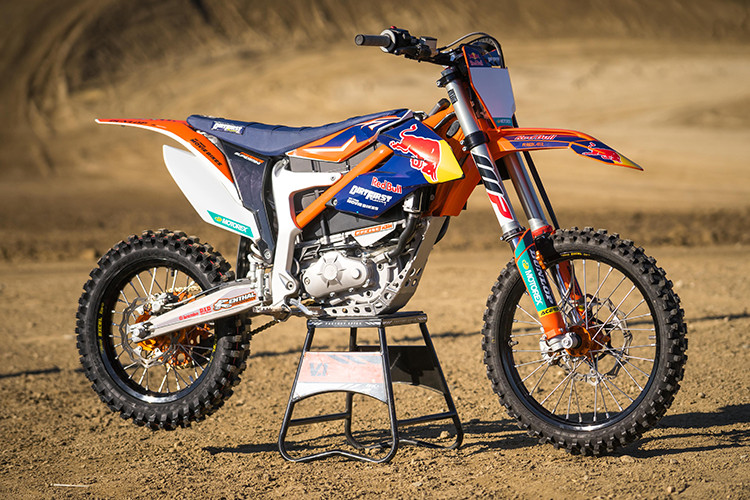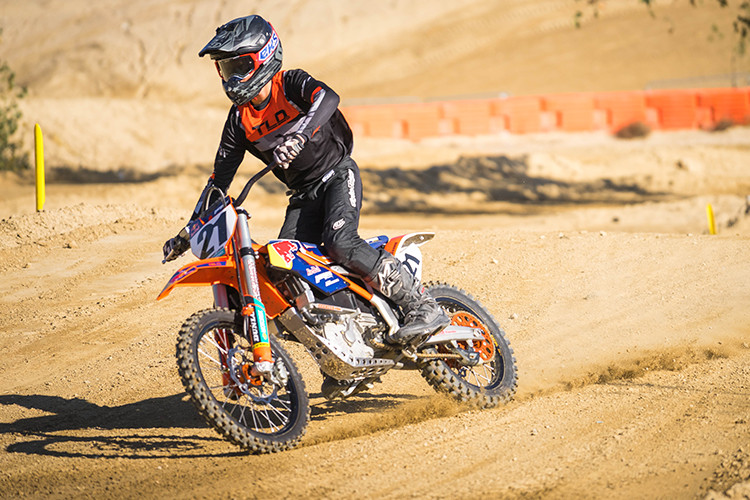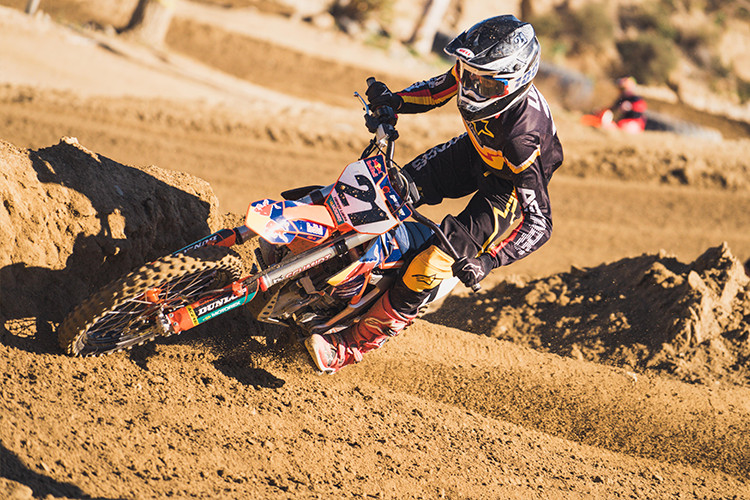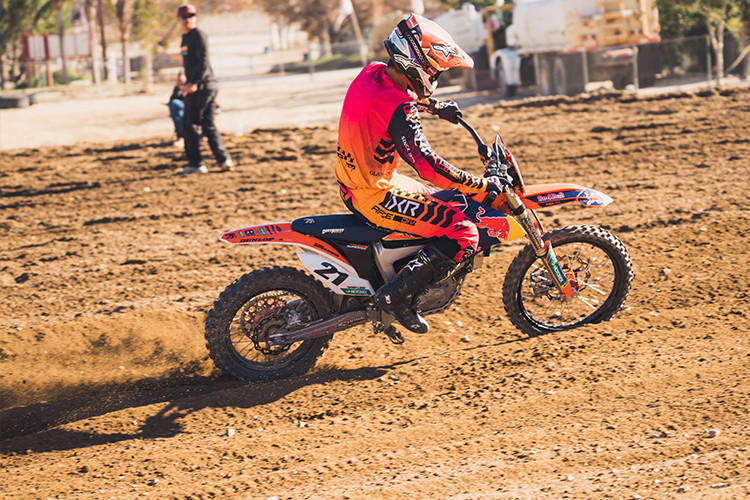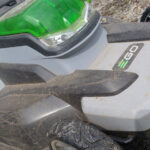Story by Jett Lessing, Photos by Trevor Hunter
Riding the Dirt First Racing custom electric KTM supermini was a genuinely enjoyable and eye-opening experience. Coming into it, I wasn’t sure what to expect, but the bike’s performance and feel were surprisingly impressive. I have some familiarity with electric dirt bikes because my younger sister races the KTM SX-E 50cc. I often ride hers around our neighborhood – it’s great for quiet practice without disturbing anyone. This quiet versatility is a key advantage of electric bikes, and whether purists like it or not, they represent a significant part of the future for motocross and off-road riding. At Dirt Bike Test, we pride ourselves on being open-minded and recognizing the benefits of reduced noise and minimal maintenance that electric bikes offer to the sport.
Let’s dive into the details of this Freeride Supermini from Dirt First Racing. The first thing that struck me was the absence of a clutch lever and shifter. Initially, this was a bit of an adjustment. Throughout the day, my hand instinctively reached for the clutch lever that wasn’t there. However, this quickly became a surprising benefit, enhancing both control and grip. With fewer fingers needed for the clutch, I could maintain a firmer hold on the handlebar, leading to safer riding. Plus, it’s one less thing to manage while navigating the track. Another aspect I appreciated was the bike’s weight, or rather, its lightweight feel while riding. Due to fewer internal engine components and less inertia, the bike felt significantly lighter on the track than its actual scale weight. It’s listed around 230 lbs fully charged, but in motion, it feels closer to half that. When I encountered kickers or got sideways on jumps, the bike was incredibly maneuverable and easy to correct. As a lighter rider myself, this was a noticeable advantage compared to heavier gas-powered dirt bikes. Smaller and lighter riders will especially appreciate the nimble feel of this electric machine.
Power delivery is a key difference compared to my usual supermini. We found ourselves needing to accelerate slightly earlier to maintain momentum, primarily due to a perceived lack of low-end power compared to gas bikes. However, the absence of a sudden power “hit” when you crack the throttle is actually beneficial for cornering. It keeps the bike settled and allows for more aggressive throttle inputs without upsetting the chassis. The smooth, linear power transition from closed to wide-open throttle provides excellent traction. The bike’s smooth power delivery made hill climbs and jumps out of corners feel effortless.
While it might not feel like the fastest bike initially, the electric supermini is surprisingly close in power and speed to its gas counterparts. The quiet operation, combined with smooth power and consistent traction, allows the bike to maintain a good pace, even if it doesn’t translate to the sensation of raw speed in your mind. It’s deceptive in how quickly it covers ground.
The run time for this KTM electric dirt bike is around 25-30 minutes at a fast pace. We had professional off-road racer Trevor Hunter complete a continuous 24-minute moto on Glen Helen’s main track before the low-power indicator lights began flashing, signaling it was nearing limp mode (under 10% battery remaining). Dirt First’s team mentioned faster mini riders have achieved approximately 29-minute motos before the bike enters limp mode. This is plenty of time for typical supermini races.
The cockpit and particularly the foot peg position are aspects that might not suit everyone immediately. The pegs are positioned further back and lower compared to standard bikes. This was a notable point of feedback on the stock Freeride E-XC among adult riders as well.
Personally, at 5’5”, I typically can’t fully grip my gas-powered supermini with my legs above the knees. However, on this electric supermini, the lower foot peg position allowed me to grip the bike with my knees and thighs. This enhanced my feeling of control, particularly when pushing through rougher sections of the track. Dirt First cleverly engineered a bracket to relocate the rear brake to a foot pedal, a significant improvement for riders like myself who aren’t fans of the hand-brake setup that some electric bikes use.
One minor inconvenience I noticed was the bike’s resistance when pushing it around without power assistance. Electric bikes without gears, meaning no neutral, can be slightly harder to maneuver manually. In off-road scenarios where pushing the bike might be necessary, this could present a slight challenge. However, the readily available torque could also help riders power out of situations where they might otherwise get stuck, mitigating this issue.
A significant advantage of electric dirt bikes, especially for owners, is their low maintenance nature. You largely avoid common engine problems and routine maintenance tasks associated with gas bikes, such as oil changes, air filter replacements, piston and clutch maintenance. The KTM Freeride features a user-friendly removable battery that can be swapped out in about 30 seconds with two people assisting. This fast battery swap is ideal for racing or extended riding sessions.
The Dirt First Racing KTM Freeride E-XC Supermini does come with a considerable price tag. With a retail price of $17,995 plus taxes and fees, it’s a significant investment for racing or recreational riding. Spare batteries are also expensive, costing upwards of $4,000 each. While the initial cost is high, it’s important to consider the long-term savings. As mentioned, you eliminate ongoing expenses like gasoline, oil, clutches, and top-end rebuilds. Furthermore, the time saved on maintenance is a valuable benefit in itself.
Electric dirt bikes also offer unique versatility in terms of riding locations and rider skill levels. The three selectable map modes on the KTM electric dirt bike can drastically reduce power output, making it safe and manageable for beginners. Conversely, the full power mode is more than capable for tackling tracks like Glen Helen National. The near-silent operation expands riding possibilities to noise-sensitive areas, such as your backyard, local fields, or neighborhoods, where traditional dirt bikes would be disruptive.
Overall, we are convinced that electric dirt bikes are not just a novelty but are genuinely competitive and can contend with gas-powered bikes. This electric supermini demonstrates significant potential. With the right rider and support team, it could very well become a future frontrunner in its class. Highlighting the real-world capability of electric dirt bikes, my sister Katin consistently competes against gas-powered bikes in mini ranks, even securing NHHA and WHS championships while racing electric. This showcases that electric is not just coming, it’s already here and performing at the top level.

